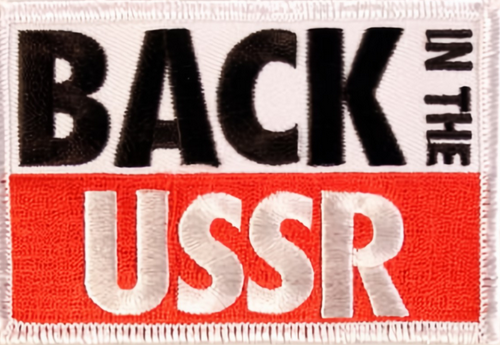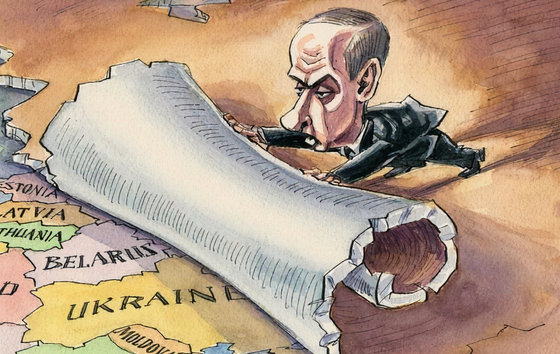Following an old Playbook
Some things you just don’t forget. My childhood television habit has left me with a mental catalogue of theme songs, advertising jingles—cigarette companies really knew how to hook you—and signature quotes.
“The story you are about to see is true—only the names have been changed to protect the innocent.”
Remember that one? Jack Webb’s 1950s procedural police drama took an everyday look at the life of an LA gumshoe, setting the tone for a popular genre we continue to find entertaining—just ask Dick Wolfe. Art may not always replicate life as it actually is, but it often comes quite close to the real thing. And like the medium that has been bringing us reality squeezed into a box or blown up onto a screen for decades, life seems prone to staging revivals, encores and sequels to its most compelling stories.
I’m not sure when I first started following the drama now unfolding in Eastern Europe. Having been born too late to witness the Second World War, I nonetheless grew up watching it portrayed in documentaries and cinematic epics. And I learned the details of its causes, courses and outcomes through trusted voices named Murrow and Cronkite. I also got a taste of its noise and brutality as interpreted by MGM, Paramount, and Twentieth-Century Fox with their battalions of heroic stars, stunt men and stereotyped villains. Even Frank Capra, who touched our hearts with everyday, next-door neighborly characters named Doe, Deeds, Smith and Bailey, made the war personal through his Why We Fight inspirational recruitment movies. The replication of life through the lens of filmmakers and actors was as entertaining as it was believable.
Admittedly our vantage point today is quite different than it was when that generation hailed as the greatest prevailed in history’s most expansive and terrible war. Fewer than half of today’s America retains first-hand or Baby Boomer recollections of what the world or America was like at mid-century. Yet now, as then, people seem to favor peace and cooperation over violence and discord, hence the priority of exhausting all diplomatic efforts before the conflagrations of war burn too hotly to be controlled or dampened.
Like most of you I have been trying to make sense of the posturing, military escalations, and Ukrainian invasion rhetoric coming from Vladimir Putin. With each new threat I have been hearing a faint, but quite recognizable off-screen voice running through my head. It is the deep-voice Dragnet narrator of my youth, now reading a text poignantly amended for this moment:
“The story you are now seeing is true—only the names have been changed to protect the perpetrators and their victims.”
If ever there was a Yogi—déjà vu all over again—moment, it may be now.
I realize that not everyone will understand this allusion. But for those of us who were the offspring of the GIs, riveter Rosies, housewives and assembly-line soldiers during World War II, the similarities with what we are now seeing and the prelude to WWII are just too real to be coincidental. It was during those grim days of economic pandemic in the 1930s, bringing most of the world to its knees, that emerging dictatorships in Europe and Asia seized the opportunity to test the limits of their ambitions. A strutting Il Duce thought the time was at hand to revive the glory that was Rome by sending his legions against the less developed nations of North Africa. A coterie of warlords from the land of the rising sun steered their new emperor into aggressive military adventures to secure an expansive resource area from China to Midway, Indonesia to the Aleutians. And on the continent an embittered soldier of the Great War rode the waves of political popularity to persuade a dispirited Germany that his kampf was one they should, and ultimately must, make their own.
The Putin-led Russian invasion of Ukraine that is now unfolding reads like a script from a movie of that era, one that is too, too familiar. Wasn’t this Hitler’s very playbook in extending his Reich, piece by piece, through occupation, annexation, and treaties with those he determined would forestall conflict at any cost? His thinly-disguised ruse to reclaim land and resources lost in the “unfair” verdicts of Versailles; his righteous defense of ethnic Germans longing for reunification with the fatherland in Austria, the Sudetenland, and East Prussia; and his overall design to enlarge his country’s living space while reaping a harvest of wheat and oil—all played out in a two-year mobilization of military, economic and patriotic might.
Hitler’s restoration of the Fatherland prior to attacking Poland in 1939.
Poland, now outflanked and outgunned, was no match for this new brand of lightning warfare. And like dominoes in line to be toppled, Hitler’s onslaught would quickly flatten Denmark, Norway, the Low Countries, France, Greece, and North Africa before he double-crossed his Soviet partners in an invasion that proved to be his undoing.
I’ve listened to Mr. Putin’s revisionist account of Ukraine’s historical interconnections to Russia. I’ve taken seriously his designs for restoring what he believes was the foolish and regrettable dissolution of the USSR on Gorbachev’s watch. Such apologetics transported me back to 1938 where, in Munich, Czechoslovakia was carved up to appease Hitler and ensure “peace in our time.” For Der Fuehrer it was both payback and a carte blanche in acquiring more territory and buffer zones. For Putin it seems much the same, as he now, through expansion, sets about deepening the moat that will separate his domain from the free and democratic countries he so fears.
Since his accession to power in 1999, Putin has cracked down on Russian dissidents, aligned with regimes that share his political agendas, and extended his influence wherever buyers were to be found. And he has orchestrated a systematic program of annexing and occupying states that once belonged in the USSR: Georgia in 2008, parts of the Crimea in 2014, Ukraine today. I wonder where the folks in Moldova and Belurus see themselves in his grand design? Will Lithuania, Estonia and Latvia be far behind? That would take him, and all us, back to the USSR in ways the Beatles never quite envisioned. And should the former Soviet satellites close ranks as they did in the glory days of the Warsaw Pact, Putin will have reversed the warming of our planet by establishing a trans-continental, northern hemispheric swath of Cold War ideology.
Beyond the obvious incursion into Ukraine a few days ago, the rest of my forecasting is nothing more than speculation based on historical precedent. But when you also weigh President Xi of China moving aggressively towards retaking Taiwan—an independent democracy that has never fallen under the communist umbrella—-the resurrection of an East-West Axis of aggression becomes harder to ignore. Equally troubling is Xi’s suppression of millions of China’s Muslim minorities, the theft of valuable technologies around the world, and the suspected viral contaminations with which we are still trying to cope. Such concerns would be unprecedented if they didn’t have so familiar a ring to them.
In taking all of this in, and trying to blend it into a world view I’ve been formulating since my youth, I have to stop myself with the reminder that we are not living in 1938. We are on the far side of jet propulsion, nuclear weapons, television, space flight and global connectivity. And even if, by way of analogy, Putin: Hitler = Xi: Tojo has some believability to it, it seems a bit simplistic whether sketched by a cartoonist or developed by an op-ed journalist. If history falls into recognizable, repetitive cycles that is because we humans are creatures of habit and terminal self-interest. But each new age and era can be as nuanced and novel as the individuals who live it and propel it forward or backward each and every day. What I can’t ignore is the fact that, on today’s geopolitical dance floor, concession, appeasement, sanctions and warfare are still the steps that either bring partners into rhythm, or drive them to not-so-neutral corners. That tells me that we are not as far removed from the impulses and agendas of our ancestors, especially those of more recent vintage who put us on a global collision course in which 85 million people lost their lives seven decades ago. For this is the predictable and often unavoidable outcome whenever power, nationalism and insecurity drive our values and fuel our ambitions. That was the case in 1938, and it may be what we’re seeing right now.
I don’t believe that the deju vu aspects of today’s news cycle will end with the outsized ambitions of a former KGB strongman in the desperate gaspings of a crumbling reign. For the human will to be free, to endure, to overcome will persist, empowering modern day Ukrainian partisans to stand up to Putin and his hordes, however long it takes. And I know they will stand up to his tyranny, for these are the descendants of the men and women who resisted Der Fuehrer’s campaign of enslavement and exhausted his playbook in trying to create a Reich without end on the very turf they are now fighting, and dying to defend. And like their forebears, they will continue to live on in both memory and valor.



